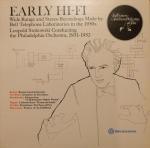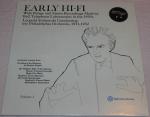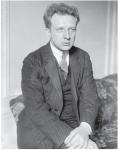前回 は、トーキー映画用のディスク録音、民生用長時間レコード、放送局用トランスクリプション盤、ベル研/WEの縦振動トランスクリプション盤など、あれこれについて調べました。
On the previous part, I studied on the history of the “sound-on-disc” soundtracks for talking motion pictures, “Program Transcription” long playing record for consumer, Electrical Transcription discs for radio industry, Bell/WE’s vertical transcription technology, etc.
今回はその続きで、放送局用の横振動記録トランスクリプション盤のあれこれ、及び初の録音再生統一カーブ “Orthacoustic” について学んでいきます。
This time, I am going to continue learning the history, including the lateral transcription records, as well as the first recording/reproducing curve ever published – called “Orthacoustic”.
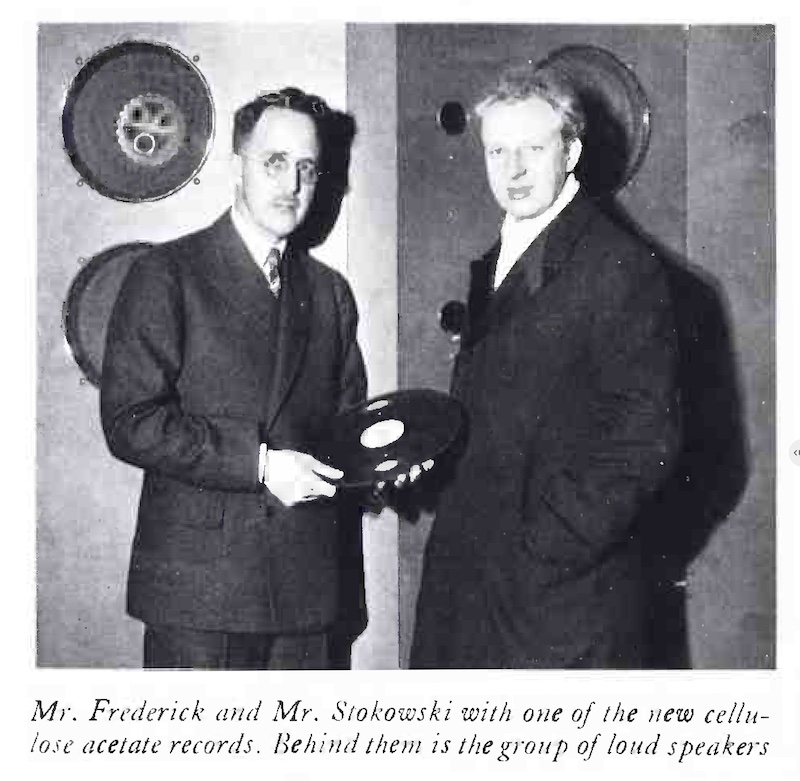
source: “Adoustical Scoiety Hears New Vertical Recordings”, Bell Laboratories Record, Vol.10, No. 10, June 1932, p.370.
- 「Pt.0 (はじめに)」
- 「Pt.1 (定速度と定振幅、電気録音黎明期)」
- 「Pt.2 (世界初の電気録音、Brunswick Light-ray、ラジオ業界の脅威)」
- 「Pt.3 (Blumlein システム、当時のRCAやColumbia、民生用における高域プリファレンスの萌芽)」
- 「Pt.4 (Vitaphone、Program Transcription、Electrical Transcription、Bell Labs / Western Electric 縦振動トランスクリプション盤)」
の続きです。
This article is a sequel to “Things I learned on Phono EQ curves, Pt.0”, “Pt.1”, “Pt.2”, “Pt.3” and “Pt.4”.
毎回書いている通り、筆者自身の学習過程を記したものですので、間違いの指摘や異論は遠慮なくお寄せください。
As I noted in every part of my article, this is a series of the footsteps of my own learning process, so please let me know if you find any mistakes on my article(s) / if you have different opinions.
今回も相当長い文章になってしまいましたので、さきに要約を掲載します。同じ内容は最後の まとめ にも掲載しています。
Again, this article become very lengthy – so here is the summary of this article (the same contents are avilable also in the the summary subsection).
20世紀を代表する指揮者の1人、レオポルド・ストコフスキー氏が、ベル研と協力して10年間近く数々の実験を行ったエピソードは、ディスク録音やステレオフォニック録音テクニックの進化発展に大きく関係しており、非常に興味深い。
Leopold Stokowski, one of the most famous conductors in the 20th century, did extensive collaboration with Bell Labs for about a decate. It is definitely a very interesting episode that the Bell Labs = Stokowski team accomplished many improvements and developments over disc recordings (and stereophonic recordings) that affected the later microgroove recording techniques.
ベル研/WEの縦振動トランスクリプション盤もハリウッドやラジオ業界で一定の支持を得て使われていたが、従来の78rpmなどと同様の横振動トランスクリプション盤がやはり多く使われた。トランスクリプション盤専門レーベルの他に、いわゆるメジャーレーベルもラジオ業界と連携してトランスクリプション盤製造を開始し、その中には RCA とその子会社である NBC による横振動トランスクリプションがあった。
Although the Bell Labs / Western ELectric’s vertical transcription discs were widely used in Hollywood and some transcription labels, majority of electrical transcription was cut laterally. Many transcription labels as well as major labels (with radio companies) started distributing transcription discs, including RCA/NBC’s lateral transcription.
1939年にRCA/NBCが打ち出した “Orthacoustic” 特性は、すでに縦振動トランスクリプションで採用されていた高域プリエンファシスを取り入れた他、重低域ターンオーバーも定義され、33 1/3回転という低速で目立つランブルノイズなどに対応した。これはのちのRIAAカーブにも引き継がれた。また、当時の録音再生イコライザはLRC回路で構成されていた(現代のフォノイコはRC回路)。
In 1939, RCA/NBC introduced the “Orthacoustic” recording. It featured treble pre-emphasis that was already used in the Bell/WE vertical transcription. Orthacoustic also introduced the third turnover frequency for low bass region, to cope with rumble noise on low speed of 33 1/3rpm. This bass turnover was later used also on the RIAA curve. The recording/reproducing equalizer for Orthacoustic consisted of LRC circuits, unlike the modern phono preamps with RC circuits.
Contents / 目次
- 5.1 Stokowski = Bell Labs Collaboration / ストコフスキーとベル研のコラボ
- 5.1.1 May 2, 1932: Acoustical Society of America / 1932年5月2日、アメリカ音響学会
- 5.1.2 Mr. Stokowski’s Oral Manifesto / ストコフスキー氏の檄文
- 5.1.3 Collaboration Started in 1931 / 1931年に始まったコラボレーション
- 5.1.4 Bell Labs = Stokowski’s Experimental Recordings / ベル研=ストコフスキーの実験録音
- 5.1.5 “Phonograph Records” article on Fortune magazine / Fortune 誌に掲載された「Phonograph Records」という記事
- 5.1.6 Example of Vertical Transcription Records / 縦振動レコードの例
- 5.2 NBC=RCA Lateral Transcription / NBC=RCA の横振動トランスクリプション盤
- 5.3 The summary of what I got this time / 自分なりのまとめ
5.1 Stokowski = Bell Labs Collaboration / ストコフスキーとベル研のコラボ
前回 Pt.4 で、Bell Labs / Western Electric の縦振動記録方式のトランスクリプション盤の技術革新について触れましたが、実はこの開発には、あの偉大なる音楽家・指揮者 レオポルド・ストコフスキー (Leopold Stokowski) が大きく関わっていました。
The previous Pt.4 featured the vertical transcription disc and its technological innovation. By the way, this invention and development stronly linked to a great famous conductor, Leopold Stokowski.
EQカーブとは直接関係ない話ではありますが、録音再生技術の歴史の1ページとしてあまりに興味深いエピソードのため、少しみていきましょう。
Although this episode has nothing to do with EQ curves, but it is really interesting, as an important part of the entire history of sound recording and reproduction – let’s take a glimpse of it.
5.1.1 May 2, 1932: Acoustical Society of America / 1932年5月2日、アメリカ音響学会
1929年に設立されたアメリカ音響学会 (Acoustical Society of America) が、1932年5月2日にベル研で開催された際、ある興味深いデモンストレーションが行われました。同様のデモンストレーションは、1931年12月にニューヨークで開催された IRE (Institute of Radio Engineers) と SMPE (Society of Motion Picture Engineers) のジョイント学会でも行われました。
Acoustical Society of America, established in 1929, held a conference at the Bell Labs in New York on May 2, 1932. In the conference, an interesting demonstration was conducted. Similar demonstration was also conducted previously in December 1931, at the joint meeting of IRE (Insitute of Radio Engineers) and SMPE (Society of Motion Picture Engineers).
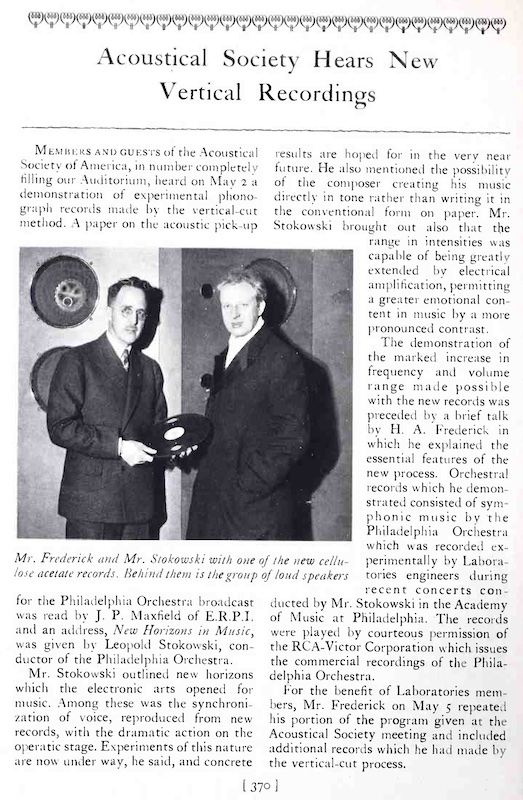
source: “Adoustical Scoiety Hears New Vertical Recordings”, Bell Laboratories Record, Vol.10, No.10, June 1932, p.370.
1932年5月2日、ベル研で行われたデモンストレーションを報じる Bell Laboratory Record 誌の記事
そのデモンストレーションでは、RCA Victor の許可の元行われたストコフスキー=フィラデルフィア管弦楽団の縦振動トランスクリプション盤による実験的録音が披露されました。また、縦振動トランスクリプションの開発者である J.P. Maxfield 氏による論文解説に続き、ストコフスキー氏自身による講演も行われました。
In those meetings, Bell Labs and Stokowski demonstrated the new vertical recording system, playing the experimental recordings of Stokowski conducting Philadelphia Orchestra, with the permission of RCA Victor. J.P. Maxfield gave the address to the audience on the technology, followed by the address by Mr. Stokowski himself.
Mr. Stokowski outlined new horizons which the electronic arts opened for music. Among these was the synchronization of voice, reproduced from new records, with the dramatic action on the operatic stage. Experiments of this nature are now under way, he said, and concrete results are hoped for in the very near future. He also mentioned the possibility of the composer creating his music directly in tone rather than writing it in the conventional form on paper. Mr. Stokowski brought out also that the range in intensities was capable of being greatly extended by electrical amplification, permitting a greater emotional content in music by a more pronounced contrast.
ストコフスキー氏は、エレクトロニック・アートによって音楽に開かれた新たな地平について説明した。その中には、レコードによって再生された声と、オペラの舞台での劇的なアクションの同期もあり、この実験は現在進行中で、近い将来に具体的な成果が期待される、と述べた。また、作曲家が従来のように紙の上で作曲するのではなく、直接音として作曲する可能性についても言及があった。さらにストコフスキー氏は、電気増幅によって記録される音の強弱の幅が大きく広がり、コントラストがはっきりすることで、より感動的な音楽になる、と明らかにした。
“Acoustical Society Hears New Vertical Recordings”, Bell Laboratories Record, Vol.10, No.10, June 19325.1.2 Mr. Stokowski’s Oral Manifesto / ストコフスキー氏の檄文
物理学者、心理学者、エンジニアを前にして行われたこの講演 “New Horizons in Music” を9ページに渡り記録した論文誌 (The Journal of Acoustical Society of America) の注釈には「この演説は原稿なしでアドリブで話されたものである」とすら書かれています。
The address, entitled “New Horizons in Music”, was done in front of physicists, psychologists and engineers, and it was “delivered extemporaneously – not read before the New York Meeting of the Acoustical Society, May 2”, according to the annotation on the Journal of Acoustical Society of America, that includes the address.
“(…) What are we trying to do? We who are dealing in sound. The ultimate aim is to send, to project, the finest quality of music that we can to as many people as we can all over the world. We have to find the means to do that. At present, they are imperfect and limited, but as we work new horizons, new possibilities, open up before our eyes. (…)”
「(…) 一体我々は何をしようとしているのか?我々は音に関わる者だ。究極の目的は、世界中のできるだけ多くの人々に、可能な限り最高品質の音楽を届け投影することだ。我々はその方法を見つけなければならないのだ。現時点においては、まだ不完全であり限定されているが、我々の努力により、新たなる地平、新たなる可能性が、眼前に現れることになるのだ。 (…)」
“(…) Just now you heard that symphony of Lopatnikov and many people have said to me, “That is not music at all. That is just noise.” How are we to determine where is the borderline between noise and music? Frankly, I don’t know. Does anybody really know? It seems to me that we have to bring broader conceptions into our work to discover that borderline. The probability is that it will be solved by a combination of the work of physicists, musicians, and of psychologists.”
「(…) さきほどロパトニコフの交響曲を聴いてもらったわけだが、多くの人が私にこう言った。『あれは音楽とは言えない。ただのノイズだ。』と。だが、ノイズと音楽の境界線をどうやって決定できるというのか? 率直に言って私にも分からない。誰かこの問いに答えられる人は? この境界線を明確にするには、我々の行う研究・実験・作業に、より広いコンセプトを持ち込む必要がある、私はそのように思っている。そして、物理学者、ミュージシャン、そして心理学者の共同作業によって、答えが導かれる可能性があるだろう。」
New Horizons in Music, Leopold Stokowski, The Journal of the Acoustical Society of America, 4, 11 (1932), p.11その講演はほとんど檄のようにも感じられます。
Mr. Stokowski’s address sounds like an exhortation, or even an agitation.
エンジニアでも開発者でもないストコフスキー氏が、ここまで積極的に協力し、そして積極的に発言していること自体に驚かされます。
It is very surprising to know that Mr. Stokowski, who was not an engineer nor a developer himself, tried to do such active colllaborations, tried to speak actively at the conference.
Tehnology and Culture という学会誌の1983年1月号に掲載された有名な論文 “Stokowski and the Bell Telephone Laboratories: Collaboration in the Development of High-Fidelity Sound Reproduction” (Robert E. McGinn) では、ベル研とストコフスキーの共同作業がこんにちの録音再生技術にもたらした数々の貢献について、生々しいドキュメントのように綴られています。
The famous paper entitled “Stokowski and the Bell Telephone Laboratories: Collaboration in the Development of High-Fidelity Sound Reproduction” (Robert E. McGinn), that was published in the Technology and Culture Journal, Jan. 1983, features the whole story of the collaboration of Bell Telephone Laboratories and Mr. Stokowski, as well as their fruitful contributions to the current recording/reproducing technology.
この論文は入手が難しいかも知れませんが、非常に読み応えがあって、一読をお勧めします。
This paper may be hard to obtain, but it’s really worth reading – highly recommended.
(…) Fifth, Stokowski was keenly interested in acoustics and audio technology and in the role they could play in realizing his “ultimate arm” (…)
… 5つ目に、ストコフスキーが音響やオーディオ技術、ひいてはそれらが彼の「究極の腕」として機能させることに、強く関心をもっていた。 …
(…) In the process of recording, Stokowski was “not content merely to conduct and leave all else to the engineers. Microphone placement, the seating arrangement of his orchestra, sound reflectors, monitoring panels – the entire paraphernalia of recording intrigued him.” His fondness for manipulating sound controls became legendary. (…)
… レコーディングにおいてもストコフスキーは、単に指揮をして、他のことは全てエンジニアに任せる、ということに満足していなかった。マイクの位置、オーケストラの座席配置、音響反射板、モニターパネルなど、録音に関わるあらゆる道具や機材に強い興味を持っていた。 …
“Stokowski and the Bell Telephone Laboratories: Collaboration in the Development of High-Fidelity Sound Reproduction”, Robert E. McGinn, Technology and Culture, Vol.24, No.1, Jan. 1983, pp.44-455.1.3 Collaboration Started in 1931 / 1931年に始まったコラボレーション
そんなストコフスキー氏がベル研究所を初めて訪れたのは1930年4月のことだそうで、研究者たちと意気投合したそうです。その1年後、1931年4月8日にストコフスキー氏が Western Electric の Harry D. Arnold 氏に送った手紙には、以下のような提案があったそうです。
Interestingly enough, Mr. Stokowski visited the Bell Telephone Laboratories for the first time in April 1930. They discussed a lot, and hit it off together. Then a year later, Mr. Stokowski wrote a letter to Harry D. Arnold of Western Electric, with a pivotal offer:
“If … I or the Philadelphia Orchestra can be of any service to you in any sound experiments we are always at your disposal. These experiments could be made during the rehearsals, so that there would be no expense incurred whatever. We never have anybody at the rehearsals so that the experiments could be private and the results could be kept confidential if you so wish.”
「もし、私(Stokowski)やフィラデルフィア管弦楽団が、ベル研における音響実験研究において、何がしかお役に立てることがあるのならば、いつでもご相談ください。実験をリハーサル中に行えば、費用は一切かかりません。リハーサルには誰も同席させないようにすれば、非公開で実験を遂行でき、またご希望であれば実験結果も秘密にしておけます。」
“Stokowski and the Bell Telephone Laboratories: Collaboration in the Development of High-Fidelity Sound Reproduction”, Robert E. McGinn, Technology and Culture, Vol.24, No.1, Jan. 1983, pp.46-47実はストコフスキーは、NBC (National Broadcasting Company, RCA の子会社) と、1930〜31年のコンサートをラジオでライブ放送することになっていて、1930年8月に NBC が録音中継機材を設置完了し、実際にラジオ生中継が実施されたのですが、そのクオリティに満足せず、ベル研に相談を持ちかけたということのようです。
As a matter of fact, Mr. Stokowski and NBC (National Broadcasting Company, subsidiary of RCA) was doing the live broadcast of the Philadelphia Orchestra’s 1930-31 concert season. NBC already installed the broadcasting equipment in August 1930, and so did the live broadcast several times, that disappointed Mr. Stokowski. He was not satisfied with the sonic quality of NBC radio broadcasts, and it would be the primary reason for Mr. Stokowski to give an offer to the Bell Labs.
While his general interest in and prior involvement with new audio technology are relevant considerations, the proximate reason was probably Stokowski’s disappointment with the sonic quality of radio broadcasts at that time, including the NBC broadcasts of the Philadelphia Orchestra which had begun in the 1929-30 season. As noted, in August 1930 Stokowski had high hopes that the NBC equipment would significantly improve the audio quality of the coming broadcasts. That he should send the letter tendering the invitation on April 8, 1931, only three days after the fourth and last NBC broadcast-but not the last set of concerts by the Philadelphia Orchestra for 1930-31 – strongly suggests that he was dissatisfied with the results.
ストコフスキー氏の、新しいオーディオ技術に対する興味や関わりも考慮すべき点ではあるが、(ベル研に手紙を送った)最大の理由は、1929〜30年シーズンに始まった、フィラデルフィア管弦楽団のNBCラジオ放送を含めた当時のラジオ放送の音質に対する失望であろう。前述の通り、1930年8月にNBCが新たに設置した機材によりラジオ放送の音質が大幅に向上するのでは、と大きな期待を寄せていた。しかし1931年4月8日(1930〜31年シーズンの公演全終了後ではなく)NBCによる4回目そして最後のラジオ生中継が終わった3日後に手紙を送ったということは、ラジオ放送の結果に不満を持っていたことを強く示唆していると考えられる。
“Stokowski and the Bell Telephone Laboratories: Collaboration in the Development of High-Fidelity Sound Reproduction”, Robert E. McGinn, Technology and Culture, Vol.24, No.1, Jan. 1983, p.471931年秋、フィラデルフィア交響楽団の本拠地であるアカデミー・オブ・ミュージックに、満を持して縦振動記録システムが導入され、1931年〜1932年にかけて、数えきれないほどの実験録音が行われました。それらは市販目的ではなく、楽曲全通しでの記録はほとんどなく、特にダイナミックレンジが広い特定の楽章のみの録音などが多くを占めていたそうです。
Finally in the Fall of 1931, Bell Lab’s vertical recording system was installed at the Academy of Music, the home of the Philadelphia Orchestra. Soon after that, during the 1931-32 season, numerous experimental recordings and exploratory research were conducted. All the recordings were not aimed for being sold commercially: specific movements of musical pieces like symphonies and suites (that had broad dynamic range) were recorded experimentally to test and research the vertical recording technology.
その中には、1932年3月12日に録音された、スクリャービンの交響曲第5番 Op.60「プロメテウス: 火の詩」や、ムソルグスキーの「展覧会の絵」もあり、これらが世界初の「意図的に」記録されたステレオ録音となっています(デューク・エリントンの1932年2月3日録音、Program Transcription 用のメドレーは、2系統で同時録音したものをシンクロ再生するとステレオに聞こえるもので、ステレオ録音を意図したものではありませんでした)。
Some of these recordings include the excerpts from Scriabin’s Symphony No.5 “Prometheus: The Poem of Fire”, Op.60 and Mussorgsky’s “Pictures at an Exhibition”, recorded on March 12, 1932 – both of which turned out to be the world’s first “intentional” stereophonic recordings. (Duke Ellington’s Feb. 3, 1932 medley recording for the Program Transcription record was an “accidental” stereo recording, recorded simultaneously with two recording machines.)
1933年4月27日には、ワシントンDCとペンシルバニアやフィラデルフィアを電話回線でつないだ壮大なステレオフォニック公開実験が行われました。この際には、当時の民生用レコードやラジオ放送を凌駕する、10,000Hz〜13,000Hz に至る周波数特性を実現したと言われており、招待客を驚かせました。ディスク録音は関係ありませんでしたが、ここでもストコフスキー氏は舞台裏でコントロール機材を操作するなどしていたそうです。その他、1940年に至るまで、3チャンネルステレオ高音質フイルム録音を含む、数多くの共同実験が行われました。
Also on April 27, 1933, experimental demonstration was held at Constitution Hall in Washington, DC., featuring a wired telephone transmission among Pennsylvania, Philadelphia and Washington. This was the grand unveiling of stereophonic sound up to 10,000Hz or to 13,000Hz, in front of a distinguished crowd. Then many other collaborations lasted until 1940, including three channel high quality stereophonic recording optically on films.
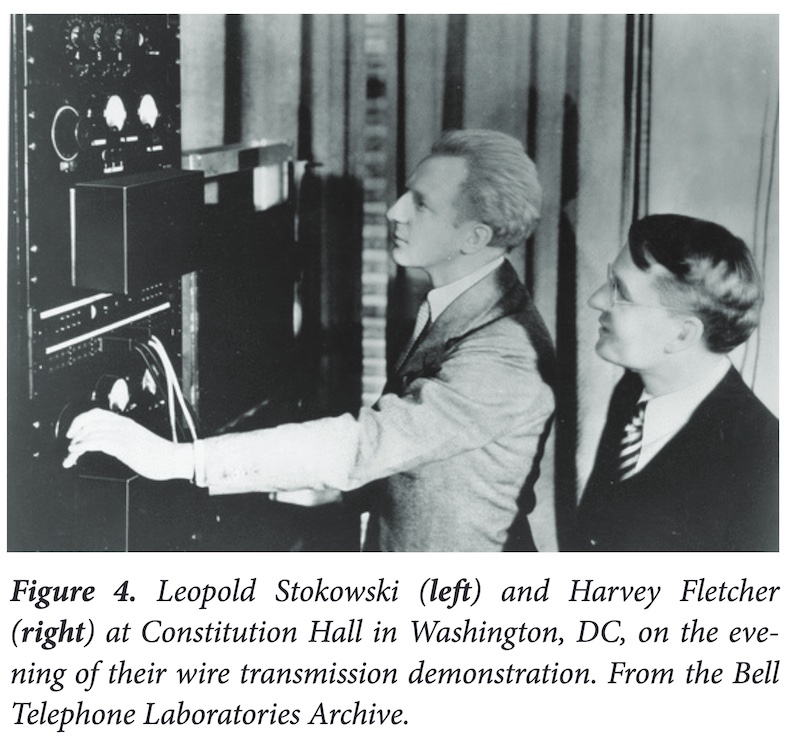
source: “The New Age of Sound: How Bell Telephone Laboratories and Leopold Stokowski Modernized Music”, Gabrielle E. O’Brien, Acoustics Today, Volume 14, Issue 2, Summer 2018, p.22.
5.1.4 Bell Labs = Stokowski’s Experimental Recordings / ベル研=ストコフスキーの実験録音
これら実験録音からプレスされた盤は、冒頭のアメリカ音響学会など幾多の1930年代のデモンストレーションで披露されたのみで、マスターやスタンパー等はずっとベル研の倉庫に厳重に保管されていました。
These experimental recordings were pressed to cellulose acetate discs, and used for several demonstrations. But they were not sold publicly – masters and stampers were kept and archived in the Bell Labs’ vault.
1979年〜1980年に、ベル研がそれらのマスターを元にして2枚のLPとして限定復刻し、一般のリスナーも1931年〜1932年のベル研=ストコフスキーの(当時としては)革命的な録音を耳にすることができるようになりました。私家盤・海賊盤的なものを除くと、正式にCD化はされていないようです。
It was in 1980 when Bell Laboratories finally released two long playing microgroove records featuring these experimental recordings, although they were limited edition. Nearly fifty years after the recordings, we can finally listen to these revolutionary (at that time) and invaluable recordings from 1931-1932. As far as I know, these recordings has not been reissued on CD format, except some private issues.
“Early Hi-Fi” (Bell Telephone Laboratories BTL-7901), released in 1979
“Early Hi-Fi Volume 2” (Bell Telephone Laboratories BTL-8001), released in 1980
Side-2 label of Bell Telephone Laboratories BTL-7901
この時期の Bell Laboratories / Western Electric で活躍された Arthur C. Keller 氏に行われた、1973年の口頭インタビュー がまとめられていました。Keller 氏の肉声も聞ける、非常に貴重な資料です。
I was surprised when I found this – An oral interview with Arthur C. Keller, one of the men who worked hard at the Bell Telephone Laboratries and Western Electric during these years, conducted in 1973. You can listen to his own voice on this webpage, and it’s definitely invaluable.
ストコフスキーに関する決定版ウェブサイト “The Stokowski Legacy” でも、ストコフスキーとベル研とのコラボレーションに関する Gabrielle E. O’Brien 氏の秀逸なまとめ記事 “Leopold Stokowski, Harvey Fletcher and Bell Laboratories: Experimental High Fidelity and Stereophonic Recordings 1931-1932” を読むことができます。
Also, the definitive Stokowski website “The Stokowski Legacy” has a very detailed story of Stokowski=Bell Lab collaboration, entitled “Leopold Stokowski, Harvey Fletcher and Bell Laboratories: Experimental High Fidelity and Stereophonic Recordings 1931-1932” by Gabrielle E. O’Brien.
その他、ASA (Acoustical Society of America) の機関誌「Acoustics Today」の2018年夏号 (Volume 14, Issue 2) にも、ストコフスキーとベル研のコラボに関する記事 “The New Age of Sound: How Bell Telephone Laboratories and Leopold Stokowski Modernized Music” が掲載されており、必読です。バイノーラル実験録音についても触れられています。
Another article on Stokowski=Bell Lab collaboration is on Volume 14, Issue 2 (Summer 2018) of “Acoustics Today”, ASA (Acoustical Society of America), entitled “The New Age of Sound: How Bell Telephone Laboratories and Leopold Stokowski Modernized Music” – also worth reading. It also features experimental binaural recordings.
IEEE InSight でも、ベル研=ストコフスキーのコラボレーションに関する Hochheiser 博士の解説記事を読むことができます。
IEEE InSight also features an article of Bell Labs=Stokowski collaboration, written by Sheldon Hochheiser, Ph.D..
5.1.5 “Phonograph Records” article on Fortune magazine / Fortune 誌に掲載された「Phonograph Records」という記事
Bell Labs / Western Electric の縦振動記録方式は、最終的にはディスクレコードの主流になることはありませんでしたし、民生用レコードとして復活することもありませんでしたが、横振動トランスクリプションと並んで1930年代〜1940年代のラジオ業界を支えた貴重なプロフェッショナル用メディアでした。また、現在に至る高音質レコードの先駆けとなる重要な技術革新を成し遂げました。
Unfortunately, Bell Labs / Western Electric’s vertical transcription discs did not become the mainstream technology as the history proves; it didn’t make a comeback as a new consumer/home phonographs. However, as we have seen in Pt.4 and Pt.5 (this) of my article, it surely played a very important role as electrical transcriptions for radio industries, as well as in Hollywood. Also, it brought significant contributions to the high fidelity of sound for the coming years.
そして、その高音質を評価した当時の人々の中は、民生用に縦振動レコードを出すべきだと主張する人もいました。歴史の長い有名なビジネス誌である、あのFortune誌の1939年9月号に掲載された長編特集記事「Phonograph Records」からは、そんな意見を垣間見ることができます。
As a matter of fact, some people in the 1930s who praised the high fidelity of vertical recorded discs, even commented that new vertical discs and players should be released also for consumers. An article entitled “Phonograph Records” in September 1939 issue of the Fortune magazine captures such opinion.
(…) It may be that the practical objections to the hill-and-dale record have been exaggerated. It would cost comparatively little to cut vertical duplicates of the lateral records when recording. The masters could be stored away for two or three years, while the standard and classical catalog was being built up, and then issued along with the announcement of a radically new phonograph playing both the old and the new types of records. A pick-up for such a machine is already in use. This course, exploited for all it is worth, might be just the shot in the arm the record industry will be needing.
縦振動記録方式に対する現実的な反論は誇張されていると言えるだろう。録音時に、横振動でカッティングするのと同時に縦振動でもカッティングするのは、比較的コストがかからないであろう。縦振動で記録したマスター盤は数年間保管でき、ポピュラー音楽やクラシック音楽のラインアップが十分に揃ったところで、旧タイプ(横振動)と新タイプ(縦振動)の両方を再生可能な、根本的に新しい蓄音機を発表し、同時にそれらの縦振動レコードを販売すればいい。実際、縦横振動両対応のピックアップはすでに実用化されている。このシナリオは、もし本当にそんなことが実現可能ならば、レコード業界がまさに必要とする一撃になりうるであろう。
There are now no home records of true high fidelity, that is, with an undistorted range extending up to 8,000 or more and down to say 40 cycles. Neither are there any phonographs widely available that would do such records justice. But there are such phonographs, and they are being played every day. The World Broadcasting System, for instance, has a big library of them, which are let out to broadcasting stations to fill in between programs. Some of them are capable of reproducing over a range of 30 t0 10,000 cycles – of emcompassing every fundamental and overtone casually discernible by ninety-nine out of a hundered human beings. (…)
現在、家庭用のレコードにおいて、40Hz〜8,000Hz を歪みなく再生できるものは存在しない。また、そのようなレコードを正当に評価できる性能を持った蓄音機も広く出回ってはいない。しかし、実際にそのような再生機器(放送局用ターンテーブル)は存在し、日々再生されているのだ。例えば、World Broadcasting System は、大量のライブラリを保有しており、放送局に貸与し、番組の合間にその音源が流れている。中には 30Hz〜10,000Hzの周波数帯域が再生可能なものもあり、100人中99人がカジュアルに聴き分け可能な基音や倍音の全てが網羅されているのだ。
Phonograph Records, Fortune magazine, Sep. 1939, pp.72-75,94,98,100,102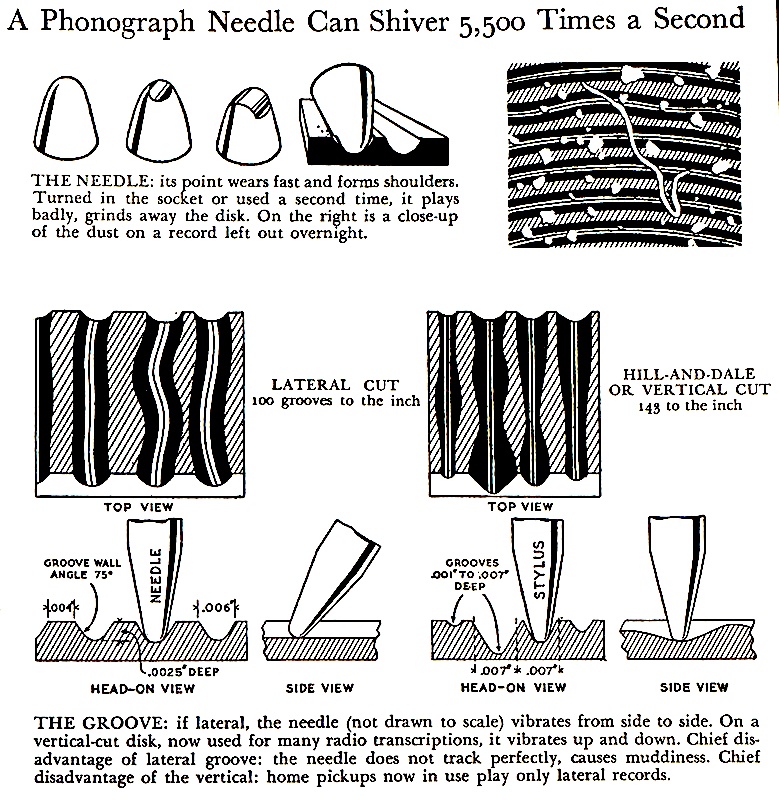
source: “Phonograph Records”, Fortune magazine, September 1939, p.75
家庭用レコードの横振動と、放送局用レコードの縦振動の比較図。横振動はトラッキング性能とそれに伴う再生音質が、縦振動は家庭用プレーヤが全て横振動用であることが、それぞれ欠点と書いています。
レコード技術とレコード業界について熱く語るこの特集記事からは、1939年当時の一般家庭におけるレコード再生環境についても間接的に読み取れるのかもしれません。実際、下の図のキャプションには、1939年当時の家庭用レコード再生における周波数特性について書かれています。
This enthusiastic article – on the history of disc record technologies and record industry – could be that it indirectly shows us what the reproducing equipments and environments at home were, as of the year 1939. As an example, the below figure has the caption that tells the frequency response capable from good home machines and records at that time in the year 1939.
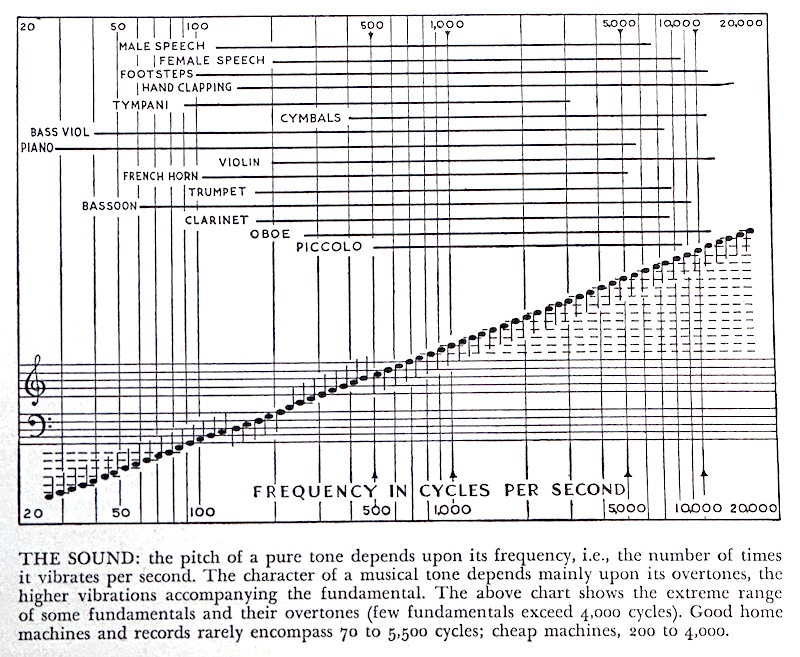
source: “Phonograph Records”, Fortune magazine, September 1939, p.75
ベル研の研究結果を借りたであろう図。下のキャプションが興味深く「家庭用オーディオとレコードで70Hz〜5,500Hzを達成できているものは稀である」「安価なオーディオではせいぜい 200Hz〜4,000Hz」とあります。1939年当時は、放送局用トランスクリプションを除き、ハイファイとは程遠い周波数特性だったことが伺えます(それと「感動する音・音楽・演奏」は別の話ですが)。
5.1.6 Example of Vertical Transcription Records / 縦振動レコードの例
最後に、日本が世界に誇るジャズSPコレクターの瀬谷徹さんのコレクションからご紹介します。
As a final part of the vertical transcription, here are some examples – the following label photos are by courtesy of Tohru Seya, one of the famous Jazz 78rpm collectors in Japan.
これらの全てに「Licensed Under US Patents of Western Electric Incorporated」と書かれていますね。
As you can see, all of these discs have “Licensed Under US Patents of Western Electric Incorporated” printed on the labels.
外周スタート・縦振動トランスクリプションの例 (1)
Example (1) of Vertical Transcription, Muzak Associated Program Service, Outside Start
外周スタート・縦振動トランスクリプションの例 (2)
Example (2) of Vertical Transcription, Muzak, Outside Start
内周スタート・縦振動トランスクリプションの例 (1)
Example 1 of Vertical Transcription, World Program Service, Inside Start
内周スタート・縦振動トランスクリプションの例 (2)
Example 2 of Vertical Transcription, World Program Service, Inside Start
縦振動トランスクリプションのスリーブの例 (1)
Example 1 of Vertical Transcription Sleeve
縦振動トランスクリプションのスリーブの例 (2)
Example 2 of Vertical Transcription Sleeve
なお、Nicholas Bergh さんによると、「縦振動トランスクリプション盤を再生する機器は RCA を含め他社も製造していたが、録音(カッティング)システムは Western Electric 社製のみで、そのEQカーブは1930年代〜1960年代の全てで1種類のみ、1942年にNABで制定された縦振動用カーブと同一」とのことでした(1942 NAB 横振動用カーブとは異なる)。
Please note that, according to Nicholas Bergh, “WE was the only company that made vertical cutting heads and systems, although others like RCA made a playback cartridge capable of vertical”, and the EQ curve for vertical transcription discs was the one throughout 1930s-1960s: “the NAB vertical curve is the WE vertical curve”. Please note that this curve is different from 1942 NAB EQ curve for lateral transcription discs.
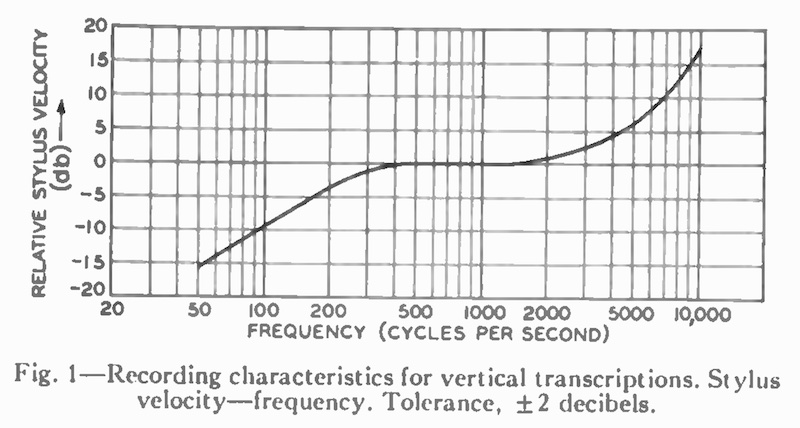
source: “Recording and Reproducing Standards”, Lynne C. Smeby, Proceeding of the I.R.E, Vol.30, No.8, August 1942, pp.355-356.
IRE (Institute of Radio Engineers, 現在の IEEE) 論文誌に掲載された、1942年 NAB カーブ(縦溝記録用)
5.2 NBC=RCA Lateral Transcription / NBC=RCA の横振動トランスクリプション盤
のちのLP時代につながる技術革新を果たした Bell Labs / Western Electric の縦振動トランスクリプションシステムは、ハリウッドの映画業界や米国ラジオ局ネットワークで広く使われましたが、ラジオ放送局用トランスクリプション盤の主流は、民生用と同じく、やはり横振動でした。民生用レコード同様に Western Electric の特許を回避して既存の技術を転用したものとなりました。
As we saw above, the vertical transcription system by Bell Labs / Western Electric accomplished technological innovation that contributed later in the advent of Long Playing Microgroove records. These vertical (“hill-and-dale”) transcriptions were widely used in Hollywood and for Radio networks. However, majority of electrical transcription discs for radio industry was, like commercial 78rpm records, lateral cut. Almost all of them were produced utilizing existing technology, avoiding Western Electric’s patents.
この時期、多くのトランスクリプション専門レーベルが誕生しましたが、最大のメジャーレーベル RCA Victor は1934年、RCA の子会社である NBC (National Broadcasting Company) と共に、自社のラジオ局ネットワークに向けて、トランスクリプション盤を録音・製造・配布を開始しました。NBC Syndicated Program Service や RCA/NBC Thesaurus などのレーベルで配布され、録音と製造は RCA Victor が担いました。ここで使われた技術もまた、のちのLP時代につながる基礎を築きました。
So many transcription labels were born in the 1930s to 1940s. Among them, one of the major labels RCA Victor entered the transcription business. In 1934, RCA and their subsidiary NBC (National Broadcasting Company) started to produce and distribute electrical transcription discs, under such labels as NBC Syndicated Program Service and RCA/NBC Thesaurus. Recordings and production were done by RCA Victor. Technologies used for these lateral transcriptions also contributed later in the LP years.
5.2.1 Advent of “Orthacoustic” curve / Orthacoustic カーブの登場
その中でも最も重要なのが、RCA/NBC によって “Orthacoustic” と銘打たれた技術でした。
One of the most important technology was “Orthacoustic”, named by RCA/NBC.
過去のさまざまな資料を私が調べた限りでは、この Orthacoustic という用語の初出は1939年12月に発行された ATE Journal というNBCの放送局エンジニア向けの雑誌でした。
As far as I have researched with various documents I could reach, the term “Orthacoustic” initially appeared on the December 1939 issue of the ATE Journal, a technical journal exclusively for the NBC’s company union called ATE (Association of Technical Employees).
ちなみに ATE というのは Association of Technical Employees のことで、社内エンジニアが International Brotherhood of Electrical Workers (IBEW) に加盟しないように NBC が組織した企業内組合のようなものだった ようです。
The ATE was formed by NBC itself, in an effort to prevent their employees from being organized by the IBEW (International Brotherhood of Electrical Workers).
結局 ATE は NBC だけの組織でいることをよしとせず、NABET (National Association of Broadcast Employees and Technicians, 全米放送局員および技術者の協会) と改名しました。そして ATE Journal はのちの1941年8月号から、Broadcast Engineers’ Journal という名前に変更され、NBC (NBC Red) / ABC (NBC Blue) も含めた NABET 加盟者向けの雑誌となりました。
After all, ATE would not stay under NBC control for long – in 1940 ATE changed its name to the National Association of Broadcast Engineers and Technitians (NABET). The ATE Journal also changed its name to Broadcast Engineers’ Journal for the NABET members including NBC (NBC Red) and ABC (NBC Blue) employees.
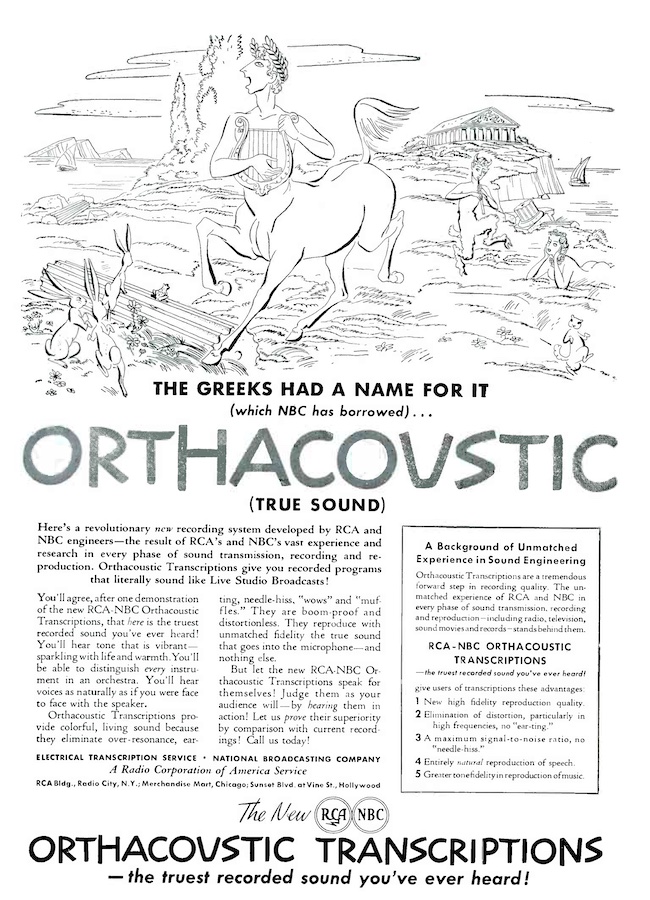
source: Orthacoustic Transcriptions Ad, ATE Journal, December 1939, p.0
ATE Journal 1939年12月号に掲載された Orthacoustic トランスクリプションの広告
5.2.2 “Orthacoustic” article in 1939 / 1939年の Orthacoustic 記事
ともあれ、Orthacoustic は NBC社内エンジニア組合向け雑誌で初めて公開されました。同じ号には、Robert M. Morris 氏による Orthacoustic の詳細な技術解説記事 “RCA-NBC Orthacoustic Recording” も掲載されています。
Anyway, the term Orthacoustic was coined initally on the magazine for NBC employees. On the same issue, a technical article “RCA-NBC Orthacoustic Recording” by Robert M. Morris introduces the detail of the Orthacoustic technology.
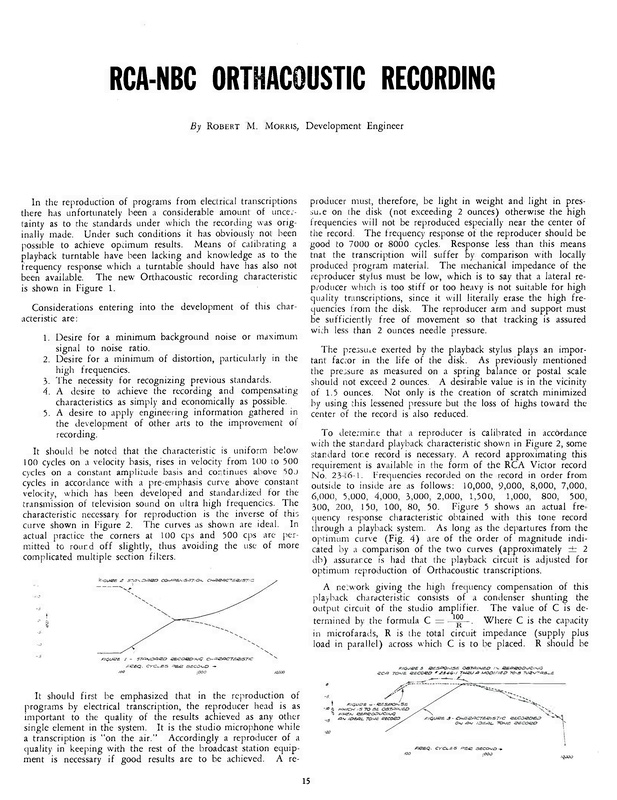
source: “RCA-NBC Orthacoustic Recording”, Robert M. Morris, ATE Journal, December 1939, pp.15-16
ATE Journal 1939年12月号に掲載された Orthacoustic 録音再生カーブの技術解説記事
この解説について、少しみていきましょう。まず冒頭では、RCA (NBC) が Orthacoustic カーブを開発した経緯について(あくまで建前かもしれませんが)書かれています。
This article starts off with the reason why RCA (NBC) decided to develop the Orthacoustic curve and its technology, although it could be just their official stance.
In the reproduction of programs from electrical transcriptions there has unfortunately been a considerable amount of uncertainty as to the standards under which the recording was originally made. Under such conditions it has obviously not been possible to achieve optimum results. Means of calibrating a playback turntable have been lacking and knowledge as to the frequency response which a turntable should have has also not been available. The new Orthacoustic recording characteristic is shown in Figure 1.
放送局用トランスクリプション盤の再生において、残念ながら、その録音がどのような規格で行われたのか不明瞭な場合が少なくない。このような状況では、当然ながら、最適な(再生)結果をもたらすことは不可能である。再生用ターンテーブル側の適切な調整手段も存在しないままであり、ターンテーブル側が備えるべき周波数特性に関する知識も不明瞭なままである。今回の新しい Orthacoustic 録音特性を図1に示す。
RCA-NBC Orthacoustic Recording, Robert M. Morris, ATE Journal, December 1939, p.15この時点ですでに、のちのLP時代同様、当時のさまざまな会社が製造する横振動トランスクリプション盤においても、録音再生カーブがレーベル間で統一されておらず、その特性や調整方法についても情報がほとんどなく、放送局での混乱があったことが伺えます。
It is very interesting to see in this part of the article that even the early days of lateral transcription discs for radio industry also had the very same issue – lack of standardization of recording characteristic – as we see the early years of Long Playing microgroove records in 1948-1955.
そして、巨大グループである RCA/NBC が、(従来よりも高音質に配慮した)新しい記録再生特性を策定することで、トランスクリプション盤市場でのシェアをより確実にし、あわよくばデファクトスタンダードの統一カーブにしようとしていたのかもしれません。
Also, I guess it would be possible that the giant group of RCA/NBC aimed solidifying market share (of electrical transcription), or even being “de facto standard”, by introducing the new Orthacoustic curve.
また、後述しますが、この時期にはすでにアセテート盤(正確にはラッカー盤)用ディスクカッターが各種開発され流通しはじめ、大手レーベルにとどまらず多くのインディレーベルや放送局でも自前でカッティングできる環境が整ってきていました。以前に比べると気軽にカッティングできる環境が整ってきたことも、録音カーブが統一されない、より正確には、それぞれの録音機器に各社めいめいの微妙に異なる録音特性が固定回路として装備されていた、という一因としてあげられるでしょう。
As I will mention later in this whole series of my articles, this confusion is also derived from the advent of acetate (lacquer) disc recording systems for individual labels, radio broadcasters and for some private use. In the early “electrically-recorded” days, only a handful of labels and companies could have the wax recording system, but in the late 1930s, professional (and/or portable) acetate recording machines were gradually available, with slightly different recording/reproducing characteristics each other.
さて、本記事に戻りますと、続いて Orthacoustic カーブの開発における目標が列挙されています。当然ながら、我々が現在家庭でレコードを再生する際にお世話になっている、民生用レコードのRIAAカーブと(パラメータは異なるものの)同じ目的です。
Well, now we’re going back to this article. The following part lists the consideration entering into the development of this (Orthacoustic) characteristic. Of course, the purpose and the target are the same as those of the RIAA curve (although the resulting parameters are different).
Considerations entering into the development of this characteristic are:
- Desire for a minimum background noise or maximum signal to noise ratio.
- Desire for a minimum distortion, particularly in the high frequencies.
- The necessity for recognizing previous standards.
- A desire to achieve the recording and compensating characteristics as simply and economically as possible.
- A desire to apply engineering information gathered in the development of other arts to the improvement of recording.
Orthacoustic 特性の開発にあたり考慮した点は以下の通りである。
- バックグラウンドノイズを最小限にしたい、または、最大限のS/N比を実現したい
- 特に高域における歪みを最小化したい
- 過去の特性についても認識し考慮する必要性
- 録音特性の実現、再生特性の実現を、可能な限りシンプルかつ廉価に行いたい
- 他分野の発展において集められた工学的な知見を、ディスク録音の改良に適用したい
5.2.3 Cutterhead + Equalizer = Recording Characteristic / カッターヘッド特性とイコライジング特性の合計
この Orthacoustic カーブについては、次のような説明が書かれています。
In this article, technical description of the Orthacoustic curve follows:
It should be noted that the characteristic is uniform below 100 cycles on a velocity basis, rises in velocity from 100 to 500 cycles on a constant amplitude basis and continues above 500 cycles in accordance with a pre-emphasis curve above constant velocity, which has been developed and standardized for the transmission of television sound on ultra high frequencies. The characteristic necessary for reproduction is the inverse of this curve shown in Figure 2. The curves as sown are ideal. In actual practice the corners at 100 cps and 500 cps are permitted to round off slightly thus avoiding the use of more complicated multiple section filters.
(Orthacoustic カーブにおいては)100Hz 以下は定速度で記録され、100Hz〜500Hz は定振幅で記録される。さらに500Hzより上については、定振幅より上になるようにプリエンファシスが行われる。この(500Hz より上の領域における)プリエンファシスは、極超短波(Ultra High Frequency, UHF)でのテレビジョンにおける音声伝送で開発され標準化されたものを援用している。このような特性で記録された盤の再生に必要な特性カーブは、図2の通りである。なお、このカーブはあくまで理想的なものであり、実際には 100Hz と 500Hz に現れる角(かど)は、ある程度丸められることが認められている。これは、理想的なカーブを実現するために非常に複雑な多段フィルタを使わずに済ませるためである。
RCA-NBC Orthacoustic Recording, Robert M. Morris, ATE Journal, December 1939, p.15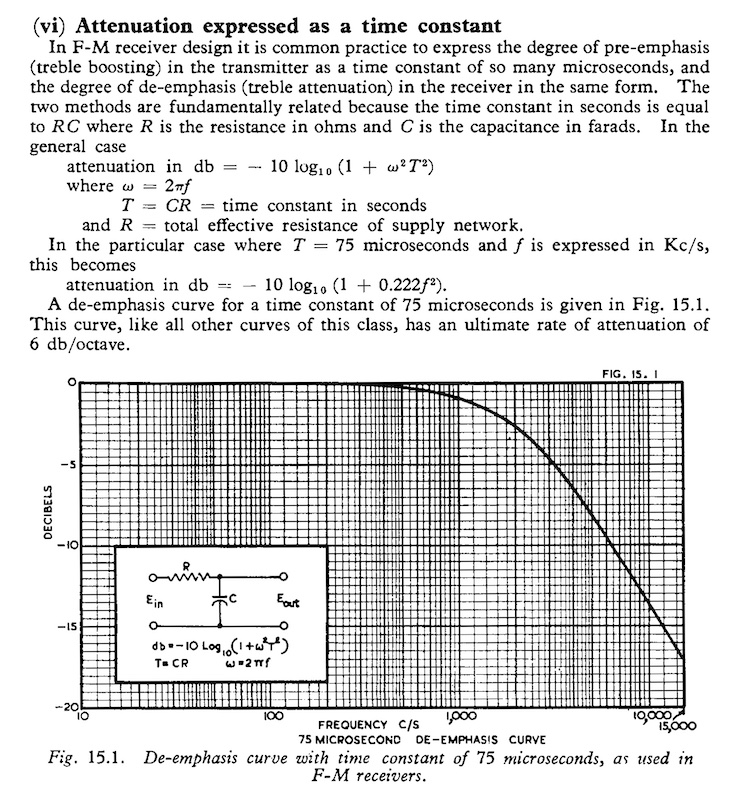
source: “Radiotron Designer’s Handbook”, F. Langford-Smith, Wireless Press, 1952, p.638
これはFMラジオ用の受信再生用RC補正回路だが、75μsの高域再生カーブとなっている
一方 Orthacoustic では録音時に 100μs LRC プリエンファシス回路が使われていた
This is the de-emphasis curve with the RC circuit with time constant of 75μs, as used in FM receivers.
On the other hand, Orthacoustic at that time was pre-emphasized with LRC compansation circuit, with time constant of 100μs
図1(録音カーブ)と図2(再生カーブ)が当該記事に掲載されています。
Figure 1 (solid line) is the Orthacoustic recording curve, while Figure 2 (dotted line) is the Orthacoustic reproducing curve.
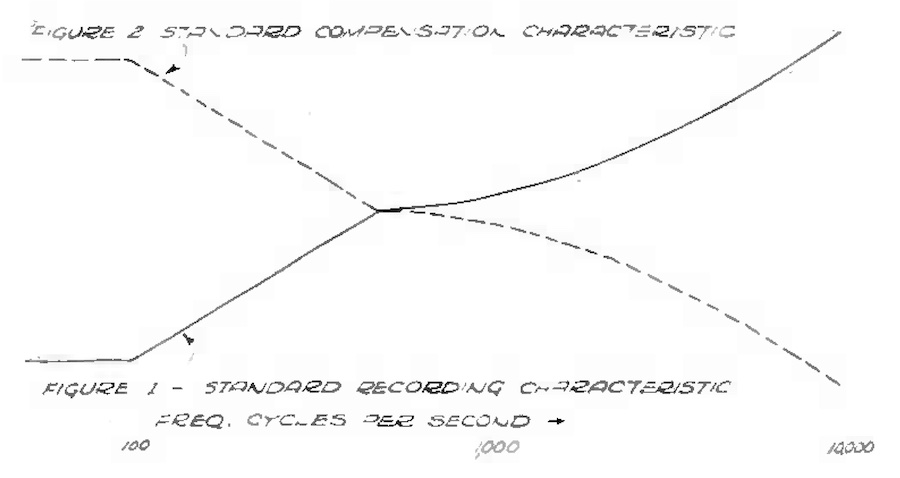
source: “RCA-NBC Orthacoustic Recording”, Robert M. Morris, ATE Journal, December 1939, pp.15-16
ATE Journal 1939年12月号に掲載された Orthacoustic 録音再生カーブ
Figure 1 (実線) が録音カーブ、Figure 2 (破線) が再生カーブ
Bell Labs / Western Electric の縦振動トランスクリプションのカーブと比べると、縦振動用カーブでは 500Hz〜1,500Hz あたりが定速度的にフラットであったのに比べて、こちらは 500Hz からなだらかに定振幅に向かってゆるやかなカーブを描いているのがみてとれます。
Compared with the recording curve for the Bell Labs / Western Electric’s vertical transcription that has a flat region (approximately between 500Hz and 1,500Hz) as constant velocity, we see this Orthacoustic curve (for lateral transcription) shows rather gentle slope toward constant amplitude.
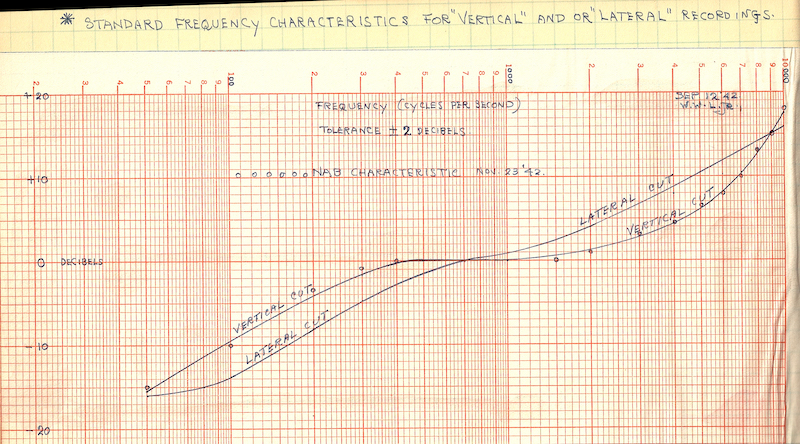
Western Electric Vertical/Lateral Recording Characteristics (1942 NAB), drawn on Nov. 23, 1942
Western Electric 社の縦振動/横振動用録音カーブ (1942 NAB vertical/lateral) をプロットした貴重なグラフ (Nicholas Bergh さん提供)
photo courtesy of Nicholas Bergh.
前回も掲載したこのカーブ比較で、縦振動用カーブ(Bell/WE)と横振動用カーブ(1942 NAB = Orthacoustic)の違いがみてとれます
This invaluable graph shows the difference between two NAB curves – vertical vs lateral.
最大の違いは、重低域におけるターンオーバー周波数が追加されていることです。この Orthacoustic では 100Hz がその値です(ちなみに後年の RIAA では 50Hz)。この第3のターンオーバー周波数が導入されたのは、33 1/3回転という低い回転速度が関係しています。78回転の時にはあまり問題になりませんでしたが、33 1/3回転ではランブルノイズやレコードの反りからくるノイズへの対策が必要になり、重低域ターンオーバーがないと、再生時に重低域の増幅に伴ってそれらの重低域ノイズも増幅され、最悪の場合アンプやスピーカーユニットを破損する恐れがあるからです。
The most significant difference from the Bell/WE curve for vertical transcription is, that the third turnover frequency at the low bass (100Hz for this Orthacoustic – while the RIAA at 50Hz). This turnover was introduced because of the slow rotating speed like 33 1/3rpm: the change from 78rpm to 33 1/3rpm caused the turntable rumble and record-warp noise also became lower in frequency. Without the third turnover (constant amplitude below 100Hz for Orthacoustic), low bass noise will would be boosted during the playback, and would cause the damage amplifiers and loudspeakers in the worse case.
で、これらの特性はどのように実現されていたか、というと、基本的にはラバーラインレコーダの頃からの伝統に則り、カッターヘッド自身の記録周波数特性と、イコライザによる特性の合計で実現されていました。以下の図で言うと、Fig.4 のカーブがカッターヘッド自身の周波数特性で、Fig.3 のカーブが、その前段につながれた録音用イコライザのカーブです。この両者の合計が Fig.5 となり、さきほど上でみたのと同じ Orthacoustic カーブになっているわけです。
So how was the recording characteristic was accomplished?. It was according to the tradition in a way – a combination of the cutterhead’s frequency response and the pre-emphasis equalizer. In the below figures, Fig.4 shows the frequency response of the cutterhead itself, while Fig.3 shows the curve by the recording equalizer before the cutterhead. The summation of these two curves becomes the Orthacoustic curve, which is Fig.5.
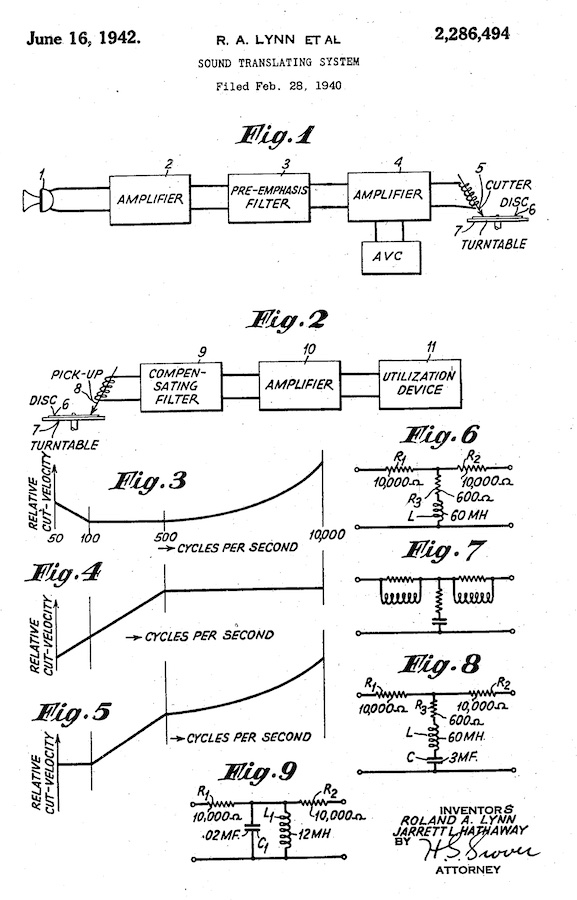
source: “Sound Translating System”, US Patent 2,286,494, Roland A. Lynn & Jarrett L. Hathaway, 1940
Orthacoustic の特許文書より
Fig.4 がカッターヘッドの記録特性、Fig.3 がプリエンファシスフィルタ(録音イコライザ)特性、Fig.5 が両者を合計した最終的な記録特性
この特許文書における Fig.8 が Orthacoustic 録音用イコライザ回路で、Fig.9 が Orthacoustic 再生用イコライザ回路です。現在の一般的な RIAA 録音再生イコライザは RC 回路(抵抗とコンデンサ)で構成されますが、当時は LRC 回路(コイルと抵抗とコンデンサ)であったことがみてとれます。この両者の違いによって、実現可能なカーブが微妙に異なります。Nicholas Bergh さんによると、現代のカーブ可変フォノイコライザ(RC回路)で当時のレコードを厳密な意味で正確に再生できない理由は、この RC vs LRC にあるそうです。この話はまたあらためて後日書く予定です。
Another mention should be the Figs 8 and 9 above – a filter circuit for Orthacoustic recording, and a filter circuit for Orthacoustic playback, respectively. Almost all of the modern RIAA EQ filters consists of RC circuits (resisters and condensers), while in these days EQ filters consisted of LRC circuits (coils, resisters and condensers) as you can see in the Figures 8 and 9. According to Nicholas Bergh, this is the reason why modern variable phono EQs (with RC circuits) cannot play such old records (cut with recording EQs with LRC circuits) precisely, to be very exact. I will write about this discussion in the coming part of my entire article.
そして、再生用カートリッジと再生用フォノイコを使って Orthacoustic カーブで記録された盤の再生が正しく行えるか、は、RCA Victor のテストレコード 2346-1 を使って計測することでチェックすると書かれています。ここでは、理想の再生特性 (Figure 4, 点線) に比べて、改造版 70-B で再生した時の再生特性 (Figure 5, 破線) は、±2dB の誤差に収まっている、とされています。
Then the RCA Frequency Test Record 2346-1 was used to calibrate a reproducer and a playback circuit (compensator): “To determine that a reproducer is calibrated in accordance with the standard playback characteristic shown in Figure 2, some standard tone record is necessary. A record approximating this requirement is available in the form of the RCA Victor record No. 2346-1. (…) Figure 5 shows an actual frequency response characteristic obtained with this tone record through a playback system. As long as the departures from the optimum curve (Fig. 4) are of the order of magnitude indicated by a comparison of the two curves (approximately ±2 dB) assurance is had that the playback circuit is adjusted for optimum reproduction of Orthacoustic transcriptions.” (source: “RCA-NBC Orthacoustic Recording”, Robert M. Morris, ATE Journal, December 1939, p.16)
ここで、理想のカーブに対しての ±2dB の誤差は、当時のプロフェッショナル仕様であっても、全く誤差の範囲内とみなされていた、ということが読み取れるのは重要です。
It is also interesting to see the ±2dB tolerance was accepted even for the professional use in these years.
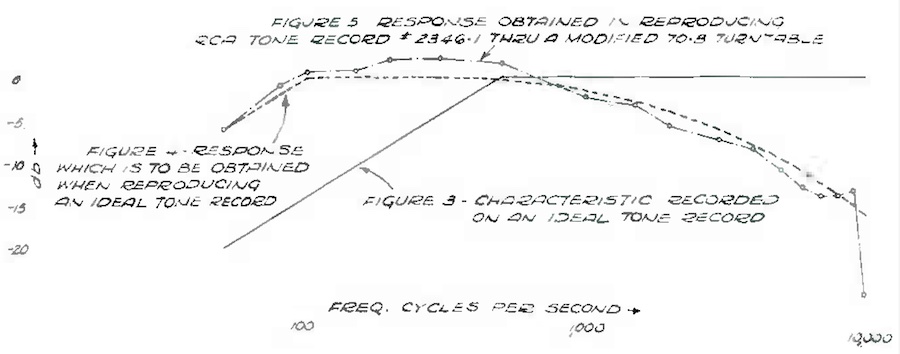
source: “RCA-NBC Orthacoustic Recording”, Robert M. Morris, ATE Journal, December 1939, pp.15-16
テストレコード 2346 を再生した際の理想的な特性 (Figure 4) と、改造版 70-B ターンテーブルで再生した際の特性 (Figure 5) の差が±2dB に収まっている、とする図
ちなみに、テストレコード 2346-1 (片面盤, 33 1/3回転) には、外周から内周に向けて、10,000Hz, 9,000Hz, 8,000Hz, 7,000Hz, 6,000Hz, 5,000Hz, 4,000Hz, 3,000Hz, 2,000Hz, 1,500Hz, 1,000Hz, 800Hz, 500Hz, 300Hz, 200Hz, 150Hz, 100Hz, 80Hz, 50Hz のテストトーンが収録されていたそうです。上の破線 (Figure 5) は、改良版 70-B ターンテーブル + MI-4856 カートリッジ + 内蔵フィルタを使って、テストレコード再生時の周波数応答をプロットしたものです。
By the way, the test record 2346-1 (single-sided, 33 1/3rpm) contained the frequencies from outside to inside: 10,000Hz, 9,000Hz, 8,000Hz, 7,000Hz, 6,000Hz, 5,000Hz, 4,000Hz, 3,000Hz, 2,000Hz, 1,500Hz, 1,000Hz, 800Hz, 500Hz, 300Hz, 200Hz, 150Hz, 100Hz, 80Hz and 50Hz. The above dashed line (Figure 5) was an actual frequency response characteristic obtained with this tone record through the modified 70-B turntable and the MI-4856 pickup (with associated internal filters).
source: “Test Record for NBC Orthacoustic Recording” – 1930s?, MLutthans, Steve Hoffman Music Forums
NBC / RCA 2346 テストレコードのレーベル
さらに、再生用ピックアップ(カートリッジ)は、最低でも 7,000Hz〜8,000Hz までの再生ができるものであること、そして針圧は 2オンス(約56.7g)以下であることが求められている、と書かれています。
Also, this article mentions that “A reproducer must, therefore, be light in weight and light in pressure on the disk (not exceeding 2 ounces) otherwise the high frequencies will not be reproduced especially near the center of the record”, and also “The frequency response of the reproducer should be good to 7,000 to 8,000 cycles”.
また、再生用フィルタ(イコライザ)の設定の仕方についても書かれており、RCA MI-4856 ピックアップの場合は専用のフィルタの設定方法、また Western Electric の WE4A ピックアップの場合に使う回路、さらには RCA AZ4211 ピックアップの場合、その他のピックアップの場合、クリスタルカートリッジを使って再生する場合についての設定方法も記されています。
Furthermore, this article mentions the associated details of the playback circuits for RCA MI-4856 pickup, for Western Electric WE4A pickup, also for RCA AZ-4211 pickup, as well as for crystal pickup.
The same filter shown in Figure 6 can, it is believed, be used with only very minor modifications in the values of the resistors and condensers for any of the magnetic type reproducers customarily used for electrical transcription purposes. The WE 4A pickup head can be compensated by removing the input condenser of 0.2 mfd and charging the condenser in the mid-section from 4 mfd to 8 mfd. For the RCA type AZ4211 lateral pickup, the same constants as given in Figure 6 will serve. For other magnetic reproducers, the same circuit should at least be suitable as a starting point from which improvements can be made by changing the condenser values and checking the result by playing the tone record. There should be no hesitancy about changing values of the circuit constants in the filter, if a playing of the tone record through the amplifier and volume indicator and subsequent playing of a transcription indicates the change to be beneficial. The final results in reproducing a record are what count.
図6と同じフィルタ(再生用EQ)は、抵抗とコンデンサの値に軽微な修正を加えるだけで、トランスクリプション盤再生で一般的に使用されているいかなるマグネットカートリッジにも使用可能であると考えられる。例えば Western Electric 社製の WE4A ピックアップに対しては、0.2μF(マイクロファラド)のインプットコンデンサを外し、中間部の 4μFのコンデンサを8μFに変更すれば補正可能である。RCAタイプAZ4211ピックアップには、図6と同じ回路で使用可能である。その他のマグネットカートリッジに対しては、まずこの回路を出発点として、各種コンデンサの容量を変更してはテストレコードで結果を確認すると良い。この際、変更したことで良い結果が得られるのであれば、フィルタの各種定数を変更することを躊躇してはならない。レコード再生による最終的な結果が重要なのである。
In the case of crystal pickup units, compensation can only be applied between a pre-amplifier and main studio amplifier or, as indicated in connection with the 70B turntable, on the output of the studio amplifier by shunting a condenser of suitable value across the circuit.
クリスタルピックアップの場合は、補正を行うのはプリアンプとメインアンプの間のみ、または70Bターンテーブルで示した通り、回路全体に適切な容量のコンデンサをシャントすることでメインアンプの出力に適用するのみである。
If it is desired to reproduce other transcriptions not having high frequency pre-emphasis with the same equipment, the compensation on the highs can be restored by placing an inductance of 7 millihenrys and not to exceet 25 ohms dc resistance in series in the midsection of the filter. This is shown in Figure 6 with a switch shorting the inductance to change the compensation.
同じ機器で高域プリエンファシスを持たない従来のトランスクリプション盤を再生したい場合は、中間部のフィルタに7mH(ミリヘンリ)、かつ直流抵抗25Ωを超えないインダクタンスを直列に配置すれば、高域補正がカットされる。図6では、インダクタンスを短絡してこの補正をオンオフさせるスイッチを示している(短絡した場合が Orthacoustic 用)。
RCA-NBC Orthacoustic Recording, Robert M. Morris, ATE Journal, December 1939, p.16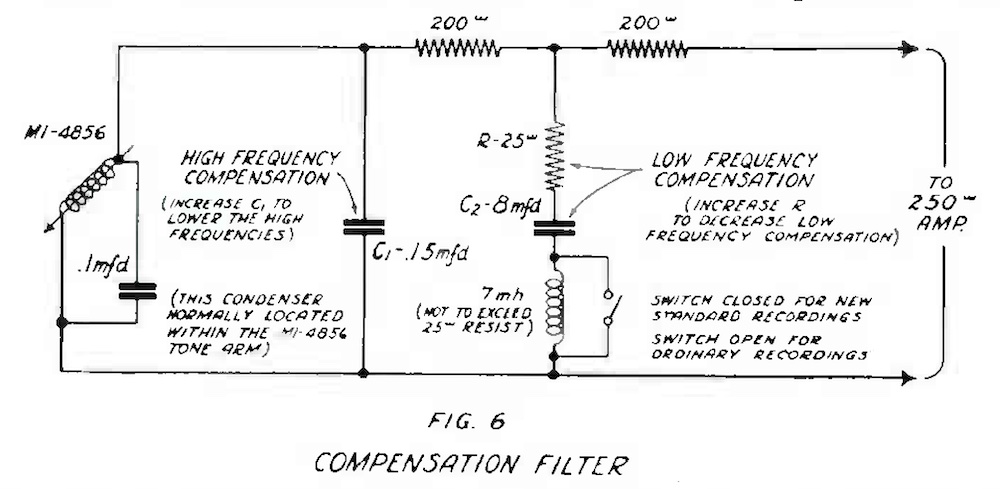
source: “RCA-NBC Orthacoustic Recording”, Robert M. Morris, ATE Journal, December 1939, pp.15-16
Orthacoustic カーブで記録されたトランスクリプション盤を RCA MI-4856 カートリッジで再生する際の回路図
Compensation Filter Circuit for Orthacoustic Transcription playback with RCA MI-4856 pickup
非常に興味深いことに、先述の Orthacoustic 特許文書での再生回路は LRC 回路であったのに、こちらの RCA-NBC Orthacoustic 解説記事での再生回路は RC 回路となっています。これが「可能な限り廉価に」と書かれたポイントになるわけですが、ディスク録音時は LRC 回路でイコライズし、完璧ではないが±2dBの誤差の範囲内に収まる RC 回路による再生イコライザを提案している、ということになります。
This figure is very interesting, that the playback compensation unit is RC circuit, while on the Orthacoustic patent document shows LRC circuit for playback compensation. This may be the point that the author noted as “compensating characteristic as economically as possible”: recording curve was accomplished with the LRC network, while the reproducing curve was obtained with RC network – not perfect but within the ±2dB tolerance compared with the optimum curve.
これら貴重な情報を読み解いても分かる通り、当時の再生用イコライザは、カートリッジに合わせて回路のコンデンサや抵抗、コイルを交換・短絡し、テストレコードでチェックするという方法が取られていた(またはその方法が推奨されていた)ということになります。現在の民生用フォノイコのように、負荷インピーダンス、インダクタンス、ゲインの設定で終わり、ではなくて、カートリッジの特性も千差万別、周波数応答特性が理想状態の ±2dB になるよう、細かく再生側の回路を修正する必要があったのです。
As you can see these invaluable information, playback compensators (playback EQs) at that time had to be modified for each pickup, by replacing the condensers and resistors, or even shorting the coils, then calibrated using the test record. Modern phono EQs just sets load impedance, inductance and gain with DIP switches or rotary switch knobs, but in these old days each phono playback cartridge had different characteristic, and detailed calibration with the test record to meet the ±2dB tolerance was necessary.
だからこそ、ラジオ業界におけるディスク記録規格標準化が求められていた、ということになると考えられます。
I believe this was one of the backgrounds of the necessity for the standardization of the recording characteristic had been gradually fostered in the radio industry.
5.2.4 Example of Lateral Transcription Records / 横振動レコードの例
再び、日本が世界に誇るジャズSPコレクターの瀬谷徹さんのコレクションからご紹介します(冒頭のものを除く)。
Again, here are some examples of the lateral transcription discs – the following label photos (except the first one) are by courtesy of Tohru Seya, one of the famous Jazz 78rpm collectors in Japan.
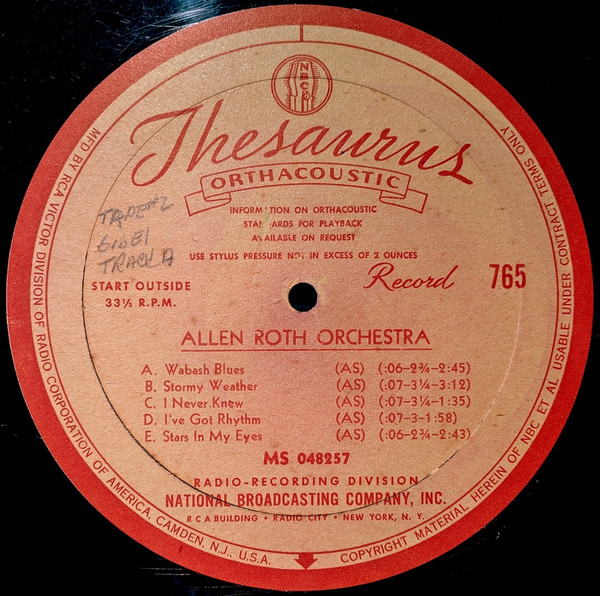
source: Discogs entry
Example of Orthacoustic Transcription Disc (NBC Thesaurus Orthacoustic MS 048257, 765), from 1940
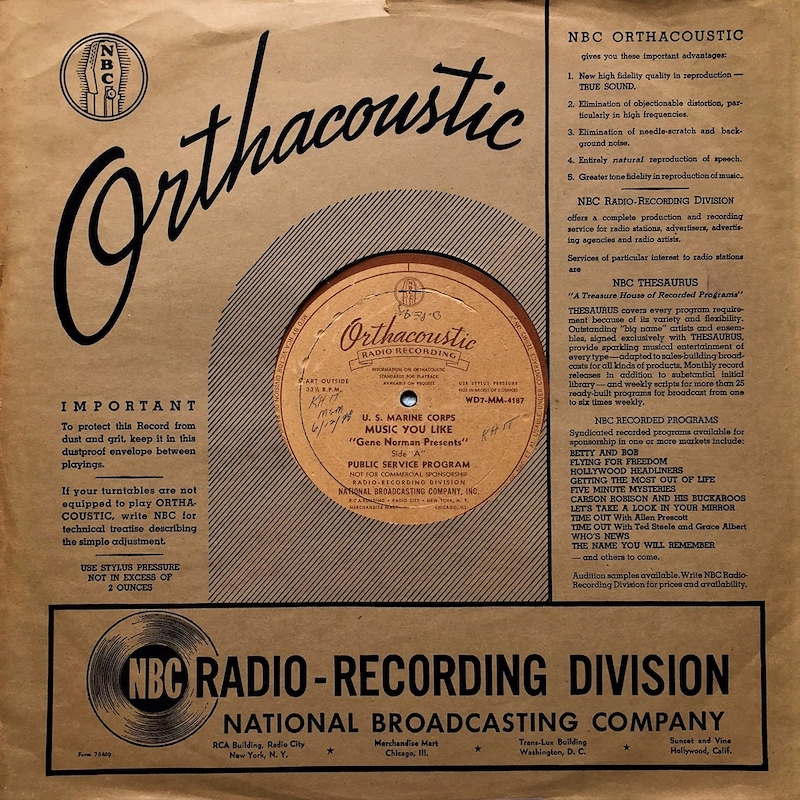
NBC Orthacoustic トランスクリプションとスリーブの例 (写真は瀬谷さん提供)
Example of Orthacoustic Transcription Disc (NBC Orthacoustic WD7-MM-4187), probably from 1940
Photo courtesy of Tohru Seya.
Orthacoustic トランスクリプションの例
Example of Orthacoustic Transcription Disc
(RCA Thesaurus EO-MM-622, 1583)
Orthacoustic トランスクリプションの例
Example of Orthacoustic Transcription Disc
(Standard Program Library YTH-2167, Q-232)
NAB (= Orthacoustic) トランスクリプションの例
Example of NAB (= Orthacoustic) Transcription Disc
(Sesac N-708, Mfd. by Columbia Recording Corporation)
NAB トランスクリプションの例
Example of NAB Transcription Disc
(Capitol Transcriptions B-201)
5.3 The summary of what I got this time / 自分なりのまとめ
今回も予想以上に長くなってしまいました(笑)。前回紹介したベル研/WEの縦振動トランスクリプション盤の開発に関連して、ストコフスキー氏が深く関わっていたエピソード、そして RCA/NBC による横振動トランスクリプション盤と Orthacoustic 特性について書きました。特に Orthacoustic 特性については、後年の RIAA カーブ同様、重低域での定速度特性が規定された最初期の例となりました。
Well, in this Part 5 article (yet again, it became a way longer than I initially intended…), I have learned so many things about the collaboration of Bell Labs / Western Electric and Leopold Stokowski; RCA/NBC lateral transcription records and its “Orthacoustic” technology. Also it should be noted that the Orthacoustic is one of the first examples of recording/reproducing characteristics that feature constant velocity in the low bass region.
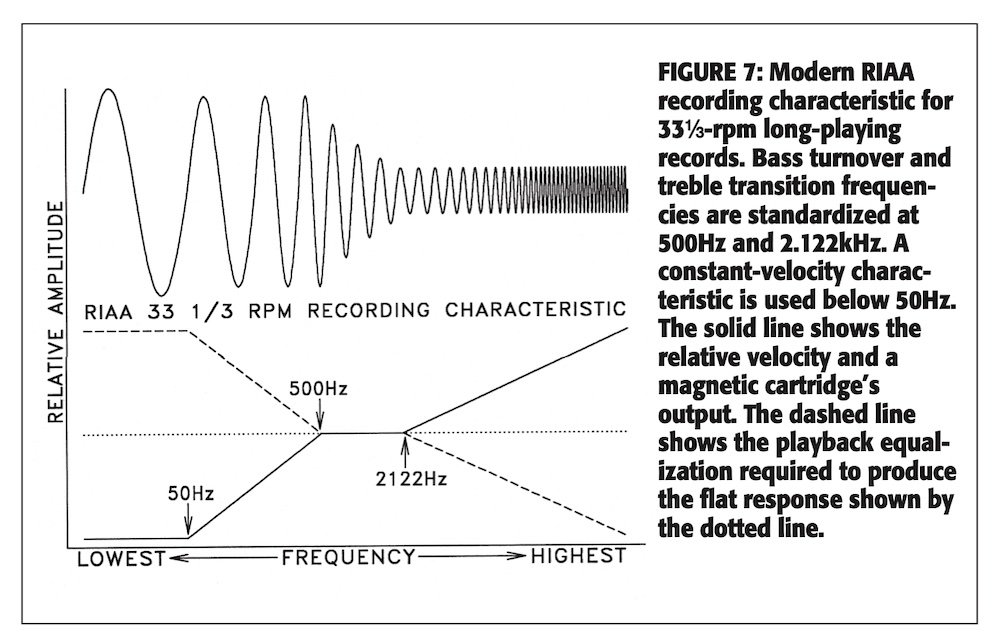
source: “Disc Recording Equalization Demystified”, The LP Is Back!, p.45-54, audio express website (1999)
これは後年のRIAA録音再生特性のものだが、1939年 Orthacoustic においてすでに、第3のターンオーバーが追加され、重低域は再び定速度で記録された。定速度〜定振幅〜定速度というパターンは現在に通じる
点線が再生カーブに相当する
Although this graph is for the RIAA recording/reproducing curve, the Orthacoustic curve in 1939 similarly applied the third turnover frequency, and the low bass region was recorded in constant velocity.
さてさて、今回の内容をざっくりまとめると、こんな感じでしょうか。
…so, the rough summary of my understanding in this article would be something like this:
20世紀を代表する指揮者の1人、レオポルド・ストコフスキー氏が、ベル研と協力して10年間近く数々の実験を行ったエピソードは、ディスク録音やステレオフォニック録音テクニックの進化発展に大きく関係しており、非常に興味深い。
Leopold Stokowski, one of the most famous conductors in the 20th century, did extensive collaboration with Bell Labs for about a decate. It is definitely a very interesting episode that the Bell Labs = Stokowski team accomplished many improvements and developments over disc recordings (and stereophonic recordings) that affected the later microgroove recording techniques.
ベル研/WEの縦振動トランスクリプション盤もハリウッドやラジオ業界で一定の支持を得て使われていたが、従来の78rpmなどと同様の横振動トランスクリプション盤がやはり多く使われた。トランスクリプション盤専門レーベルの他に、いわゆるメジャーレーベルもラジオ業界と連携してトランスクリプション盤製造を開始し、その中には RCA とその子会社である NBC による横振動トランスクリプションがあった。
Although the Bell Labs / Western ELectric’s vertical transcription discs were widely used in Hollywood and some transcription labels, majority of electrical transcription was cut laterally. Many transcription labels as well as major labels (with radio companies) started distributing transcription discs, including RCA/NBC’s lateral transcription.
1939年にRCA/NBCが打ち出した “Orthacoustic” 特性は、すでに縦振動トランスクリプションで採用されていた高域プリエンファシスを取り入れた他、重低域ターンオーバーも定義され、33 1/3回転という低速で目立つランブルノイズなどに対応した。これはのちのRIAAカーブにも引き継がれた。また、当時の録音再生イコライザはLRC回路で構成されていた(現代のフォノイコはRC回路)。
In 1939, RCA/NBC introduced the “Orthacoustic” recording. It featured treble pre-emphasis that was already used in the Bell/WE vertical transcription. Orthacoustic also introduced the third turnover frequency for low bass region, to cope with rumble noise on low speed of 33 1/3rpm. This bass turnover was later used also on the RIAA curve. The recording/reproducing equalizer for Orthacoustic consisted of LRC circuits, unlike the modern phono preamps with RC circuits.
次回は引き続き歴史を辿り、アセテート盤録音機の登場、業界を震撼させた技術論文、超軽量ピックアップの誕生あたりについて学んでいきます。
My next post will feature the continuing history, including the advent of acetate disc recorders, the technical paper that shook the industry, as well as the advent of ultra-lightweight pickup.
» 続き / Sequel: “Things I learned on Phono EQ curves, Pt.6” »

